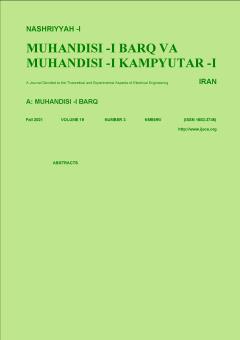بررسی جریان نشتی و دمای سطح مقره کامپوزیتی 230 کیلوولت در شرایط رطوبت و ریزگرد
الموضوعات : electrical and computer engineeringسامان محمدنبی 1 , خسرو رحمانی 2
1 - دانشگاه شهید بهشتی
2 - دانشگاه شهید بهشتی
الکلمات المفتاحية: مقره کامپوزیتی, ریزگرد, سردشدن تشعشعی, کامسول, جریان نشتی,
ملخص المقالة :
با چگالش رطوبت روی سطح مقرههای آلوده به ریزگرد، هدایت الکتریکی مقره بالا رفته و به تبع آن جریان نشتی روی سطح ایجاد شده و باعث از کارافتادگی مقرهها میشود. چگالش رطوبت روی سطح، در اثر مکانیزم سردشدن تشعشعی و عمدتاً اوایل صبح و در فصل زمستان اتفاق میافتد. در این حالت دمای سطح مقره از نقطه شبنم کمتر است. در این مقاله ضمن بررسی مکانیزم سردشدن تشعشعی، یک نمونه ریزگرد واقعی جمعآوری شده از کانون ریزگرد، آنالیز شیمیایی و هدايت الكتريكي آن در حالت مرطوب اندازهگیری شده است. با شبیهسازی مقره کامپوزیتی kV 230 آلوده به ریزگرد در نرمافزار کامسول، جریان نشتی به دست آمده و با آزمون تجربی صحتسنجی شده است. همچنین با استفاده از روابط انتقال حرارت، دمای سطح مقره هنگام عبور جریان نشتی تعیین و با مقادیر ثبتشده توسط دوربین ترموویژن در هنگام آزمون، مقایسه گردیده است. نتایج نشان میدهد که جریان نشتی و دمای سطح مقره با افزایش هدایت و ضخامت لایه آلودگی افزایش یافته و به تبع آن احتمال از کار افتادگی مقره نیز بالا میرود. آزمون تجربی نشان داد که شبیهسازی مقره با نرمافزارهای تجاری موجود، میتواند روش قابل اعتمادی برای تحلیل پیشدستانه جهت ارزیابی مقرهها به شمار رود.
[1] S. M. Kumar and L. Kalaivani, "Electric field distribution analysis of 110 kV composite insulator using finite element modeling," in Proc. Int. Conf. Circuits, Power Comput. Technol. ICCPCT’14, pp. 136-141, Nagercoil, India, 20-21 Mar. 2014.
[2] M. El-Shahat and H. Anis, "Risk assessment of desert pollution on composite high voltage insulators," J. Adv. Res., vol. 5, no. 5, pp. 569-576, Sept.. 2014.
[3] D. S. Lopes, "Potential distribution along a 500 kV polymer insulator in presence of a pollution layer," in Proc. of the COMSOL Conf., pp. 112-117, Grenoble, France, 27-29 Oct. 2015.
[4] Y. Mizuno, K. Naito, Y. Suzuki, and M. Akizuki, "Voltage and temperature distribution along semiconducting glaze insulator strings," IEEE Trans. on Dielectrics and Electrical Insulation, vol. 6, no. 1, pp. 100-104, Feb. 1999.
[5] A. Arshad, S. G. Nekahi, M. Mcmeekin, and M. Farzaneh, "Effect of pollution layer conductivity and thickness on electric field distribution along a polymeric insulator," in Proc. of the COMSOL Conf., pp. 56-59, Grenoble, France, 27-29 Oct. 2015.
[6] A. Nekahi and S. G. Mcmeekin, "Effect of pollution severity on electric field distribution along a polymeric insulator," in Proc. IEEE 11th Int. Conf. on the Properties and Applications of Dielectric Materials, pp. 612-615, Sydney, Australia, 19-22 Jul. 2015.
[7] R. Chakraborty and S. B. Reddy, "Performance of silicone rubber insulators under thermal and electrical stress," IEEE Trans. Ind. Appl., vol. 53, no. 3, pp. 2446-2454, May/Jun. 2017.
[8] J. Dadashizadeh Samakosh and M. Mirzaie, "Flash-over voltage prediction of silicone rubber insulators under longitudinal and fan-shaped non-uniform pollution conditions," Comput. Electr. Eng., vol. 78, pp. 50-62, 2019.
[9] A. Z. El Dein, "Experimental techniques to simulate naturally polluted high voltage transmission line insulators," IEEE Trans. on Dielectrics and Electrical Insulation, vol. 21, no. 5, pp. 2199-2205, Oct. 2014.
[10] P. Charalampidis, M. Albano, H. Griffiths, A. Haddad, and R. T. Waters, "Silicone rubber insulators for polluted environments part 1: enhanced artificial pollution tests," IEEE Trans. on Dielectrics and Electrical Insulation, vol. 21, no. 2, pp. 740-748, Apr. 2014.
[11] H. Benguesmia, N. M. Ziou, and A. Boubakeur, "Experimental study of pollution effect on the behavior of high voltage insulators under alternative current," Front. Energy, vol. 11, pp. 1-9, 2017.
[12] Y. G. Pushpa and N. Vasudev, "Artificial pollution testing of polymeric insulators by CIGRE round robin method-withstand & flashover characteristics," in Proc. 3rd Int. Conf. Cond. Assess. Tech. Electr. Syst., pp. 270-274, Rupnagar, India, 16-18 Nov. 2018.
[13] I. A. Joneidi, A. A. Shayegani, and H. Mohseni, "Electric field distribution under water droplet and effect of thickness and conductivity of pollution layer on polymer insulators using finite element method," Int. J. Comput. Electr. Eng., vol. 5, no. 2, pp. 266-270, Apr. 2013.
[14] Y. Bourek, N. M'Ziou, and H. Benguesmia, "Prediction of flashover voltage of high-voltage polluted insulator using artificial intelligence," Trans. Electr. Electron. Mater., vol. 19, pp. 59-68, 2018.
[15] N. A. Othman, M. A. M. Piah, and Z. Adzis, "Space charge distribution and leakage current pulses for contaminated glass insulator strings in power transmission lines," IET Gener. Transm. Distrib., vol. 11, no. 4, pp. 876-882, Mar. 2017.
[16] IEC 60507 Standard, Artificial Pollution Tests on High-Voltage Insulators to Be Used on AC Systems, Int. Electrotech. Comm. Geneva, Switzerland, 1991.
[17] CIGRE C4.303, Artificial Pollution Test for Polymer Insulators Results of Round Robin Test, Technical Brochure, 555#, Oct. 2013.
[18] ب. شفیعی و ا. میرزایی، "طراحی بهینه، ایمن و اقتصادی سیستم زمین پستهای فشارقوی،" مجله مهندسی برق و الکترونیک ایران، جلد 13، شماره 1، صص. 122-109، 1395.
[19] ع. نادریان جهرمی، م. صنایعپسند و ح. محسنی، "طراحی حلقه کرونای مقرههای پلیمری فشارقوی بر اساس شبیهسازی شدت میدان الکتریکی،" مجله مهندسی برق و الکترونیک ایران، سال 2، شماره ۲، صص. 38-30، پاییز و زمستان ۱۳۸۴.
[20] M. A. Salam, S. M. Al-Alawi, and A. A. Maqrashi, "Prediction of equivalent salt deposit density of contaminated glass plates using artificial neural networks," J. of Electrostatics, vol. 66, no. 9-10, pp. 526-530, Sept. 2008.
[21] T. S. Eriksson and C. G. Granqvist, "Radiative cooling computed for model atmospheres," Applied Optics, vol. 21, no. 23, pp. 4381-4388, Dec. 1982.
[22] Wijayatilake ACS, "Reviewing of insulator selection criteria for overhead power lines in coastal areas of Sri Lanka," Engineer, XLVII, 01, pp. 57-73, 2014.


